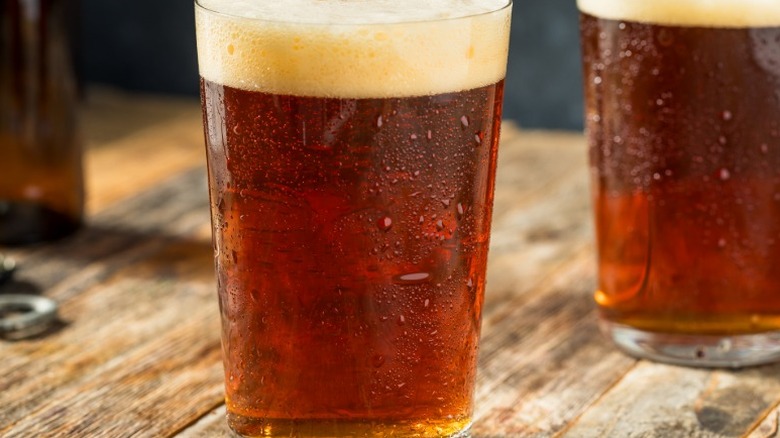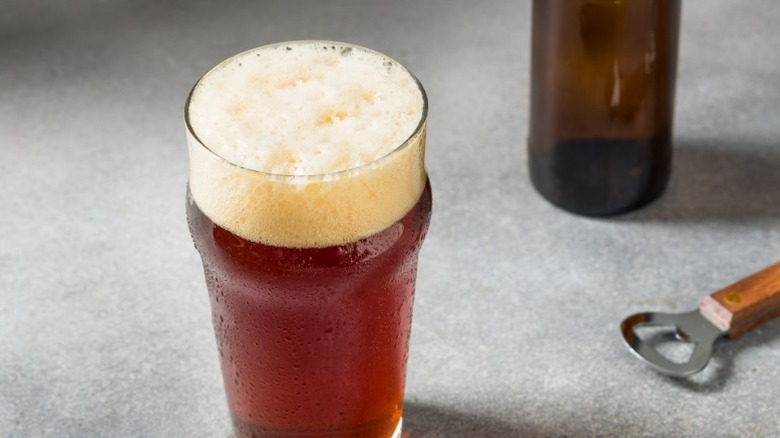Amber Vs Red Ale: What's The Difference Between Beers?
Perhaps you've ordered an amber ale while your friend got a red ale, and you both marveled at how similar they looked. Or maybe you've seen both side by side and didn't even realize you were looking at two different beer styles. Some say that people aren't even drinking beer anymore, but it's still the most popular alcoholic beverage in America by far, and it's worth knowing all the variety it has to offer. Rest assured, amber ales and red ales may look very similar due to their dark, reddish tints, but they are two distinct beer styles with their own flavor profiles and origins.
To understand these differences, it's a good idea to first look closer at their similarities. They may not be the most common types of beer today, but both red ale and amber ale have been mainstays of the craft beer world for decades. Each is more malt-forward than hops-focused, with undertones of fruit and toffee. Both types of ale also pair beautifully with lamb dishes and white meats, among other similar foods. They're also usually on the smooth side and very sessionable, making them a worthy choice if you're looking for something more easygoing that still has plenty of flavorful complexity.
Pay attention to the taste, though, and there are noticeable distinctions. Amber ales usually strike a nice balance between sweet malts and bitter hops. Red ales, on the other hand, lean more toward the malty side with a sweeter, caramel-like taste. American red ales in particular tend to pack a bit more hop punch. Basically, the two beers have a lot in common, but ambers are more easygoing, while red ales are more pronounced.
How amber ale is made
Amber ales may appear red at a glance, but look closely, and you'll find that many skew more copper or brownish-red than ruby. Amber ales began life centuries ago as a darker type of English pale ale or strong English bitter ale. However, it wasn't until American brewers in the 1980s began brewing pale ales that amber ale took off. It's tough to say if these early American craft brewers used local grains and hops because they couldn't get the English stuff or just really wanted to do things their own way — probably a bit of both, realistically — but either way, that's what happened. And, thank goodness it did, because it resulted in the amber ales we know and love today.
Amber ale is brewed in the style of any ale beer with warm fermentation and top-fermenting yeast. But it stands out from its more traditional ale predecessors by being richer in character and more malt-forward. This is because amber ales are brewed with crystal or caramel malts in the base, which add the beer's trademark amber color plus a tangible dose of caramel-like sweetness. Some recipes also add Munich malt to bring out richer undertones as well as a variety of hops for nuances of florals and citrus, but overall the beer tends to be evenly balanced and smoother than bitter. It's easy to see why these beers rose to popularity as the more flavorful counterparts to American lagers, though they've also been found at the more unique breweries around the world known for exploring different styles.
What gives red ale its rosy color?
The term "red ale" actually refers to multiple ale beer styles brewed with notable reddish tints, sometimes going into bright red or ruby territory. The most prevalent in North America are American red ales, thanks to their rise within the craft beer movement of the 20th and 21st centuries. Adapted from European red ales, they get their red color from specialty malts like roasted (often crystal malts like their amber cousins) or kilned, though roasted barley is also sometimes added to produce an even more intense hue and help enhance the fruit flavors. Compared to their ambers, red ales also tend to revolve more around the key ingredient that makes beer bitter, which are the amino acids found in hops. Some red ales, like Belgian red ales, are also aged in oak barrels for unique notes of woody spice and mellowed-out hop character.
One of the oldest red ales is the Irish red ale, which dates back hundreds of years. Unlike American reds, Irish red ales are pretty low on bitterness and don't really have much hop flavor going on (though there are of course hops in them, as there are in all beer styles). Though it's unclear why exactly the Irish began brewing beer with a considerably low focus on hops, one can assume that they were inspired by the tamer ales of nearby England and Scotland. Some of these reds are actually not traditional red ales at all, but "red beers" or "red-style ales" are brewed as lagers, which gives them a cleaner taste and really lets the malt shine through.


